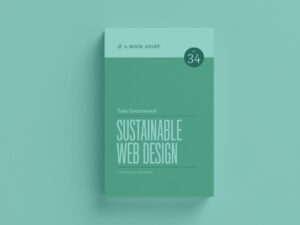
Sustainability is something that most of us try to incorporate into our daily lives – recycling, reusing, and reducing consumption where we can. However, all of these activities take place in our physical lives and few people think about the impact that their online presence has. In fact, digital sustainability is something that wasn’t spoken about much before the last few years.
Whilst it might seem abstract and intangible, the carbon impact of websites, apps and other online platforms is very real and every user experience online has an impact, too.
One aspect of digital sustainability that we’re not as familiar with, is how it can relate to user experience and accessibility. We wanted to dive a little deeper into this topic so we sat down with Sarah Edwards, Creative Director at Make it Clear.
Q: More businesses are starting to consider the sustainability of their digital and web presence. What are your thoughts on this, and what changes have you seen over the last few decades of working in UX/ UI?
Sarah: It’s been really interesting, we’re now thinking about websites and the internet as a whole ecosystem. People are having conversations about where their website is hosted as well as understanding their entire digital impact, not just the obvious page load.
We’re finding that when larger organisations are constructing their digital strategies, sustainability is now built in from the beginning.
Issues such as speed of load time, clarity of information presented and removing unnecessary information are now being actioned. And what I really like about this is it mimics the approach to online accessibility.
Considerations to accessibility on mobile, accessibility with low internet speed areas etc. are now major factors when implementing a new digital strategy. Reducing waste and making things more sustainable, tends to make them more user-friendly too.
Q: Do you consider sustainability when designing and what are the specifics you would suggest to a client?
Sarah: All projects start with implementing our UX principles, with aspects such as page load time and image size forming the sustainability component.
As an example we had a client request recently to include a whole background image. Background images, carousels, looping video as part of headers are incredibly inefficient and not sustainable as they are very memory intensive. So ideally, we would recommend a cleaner, more simple approach!
Q: What is best practice for improving a website’s user experience?
Sarah: Colour contrast, simple design with clear hierarchy and labelling of content are all the foundations of good UX. Using these approaches will also ensure your site is AAA (triple A) compliant.
AAA compliance is considered the gold standard of accessibility. To achieve this, you must fulfil all A and AA standards. In essence, your website must have a strong contrast between foreground and background. Basically, you can only use very dark colours on a very light background and vice versa. Almost all colored text fails.
Q: When a company comes to you do they tend to be thinking about their user experience?
Sarah: We talk a lot about the UX maturity scale within an organisation. Typically, when a standard business that does not operate in the digital sector approaches us, they tend to fit between two and three on the scale.
This is where UX work is rare, done haphazardly and lacks importance or is functional and promising but done inconsistently and inefficiently.
However, as companies have moved away from working face-to-face due to the pandemic to digital platforms, organisations are now investing more time and effort into their UX to support employee and customer experiences.
A result of these changes means we’re now seeing frameworks and structures becoming standardised. Everything is starting to look the same, which in one way is good as it means people can have a consistent experience; however, it also means the internet is losing its personality.
Footprint & Make it Clear
Make it Clear helps businesses bring clarity to their online communications through data-led strategic, UX, design and marketing services.
Make it Clear is part of Footprint’s partnership network, meaning we work closely together to share knowledge and achieve the best possible results for our shared clients.
Through our partnership network, we introduce clients to experts in a range of specialisms and work collaboratively with our partners on projects.




